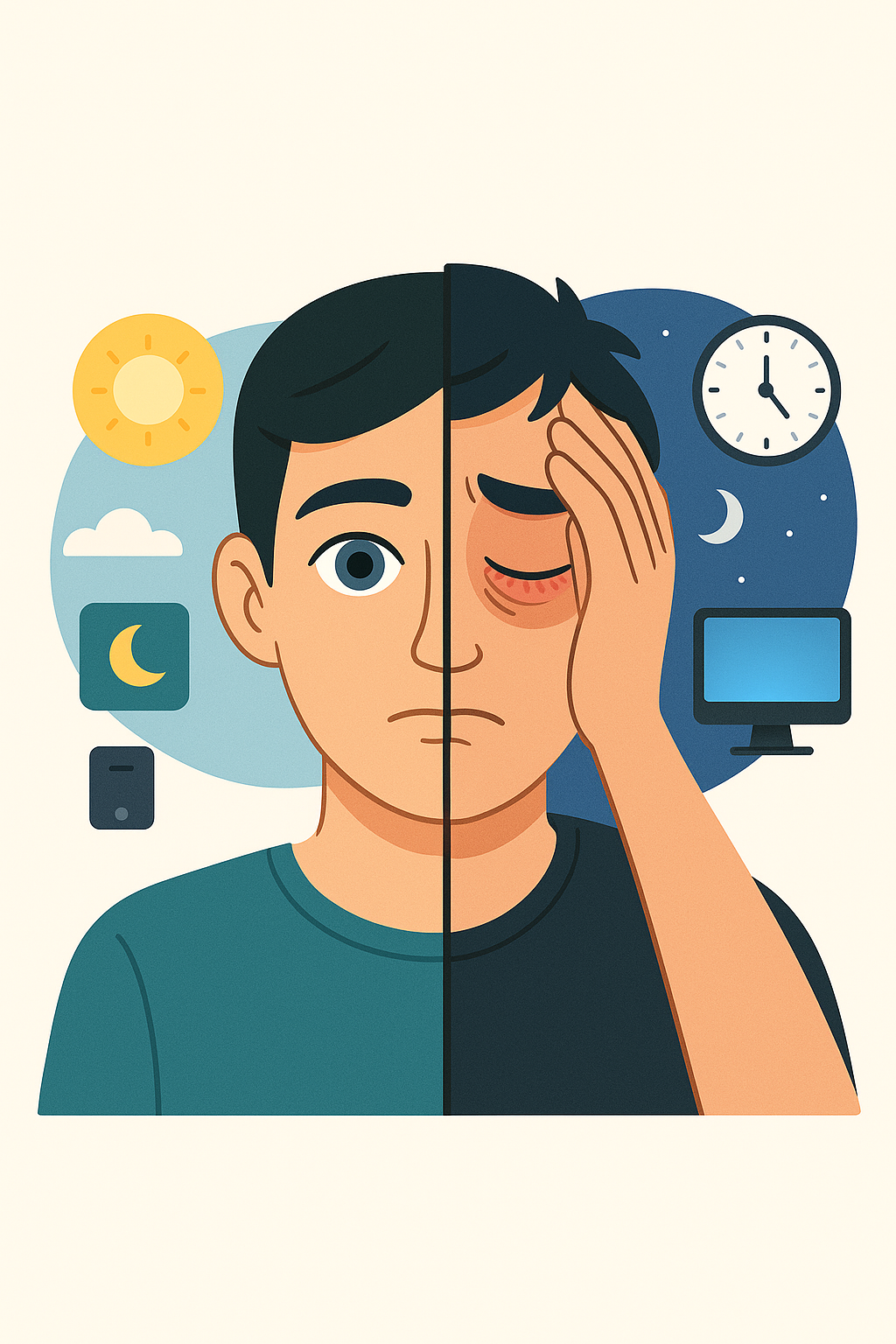Introduction
Let’s face it—we’re all glued to our screens. Whether it’s for work, play, or just scrolling through social media, digital devices dominate our daily lives. But here’s the catch: our eyes aren’t built for non-stop screen time. This is where computer vision syndrome CVS comes into play.
Also known as Digital Eye Strain, CVS is a growing concern affecting millions of people across all age groups. Think of it as the modern-day version of eye fatigue, but supercharged by technology.
👓 Blurry or Double Vision
Ever feel like your vision goes fuzzy after a long screen session? That’s not your imagination. Your eyes struggle to maintain focus, leading to blurred or even double vision if you don’t give them a break.
💧 Dry or Watery Eyes
Oddly enough, CVS can cause both dry eyes and watery eyes. Why? Because staring at a screen reduces your blink rate dramatically—by almost 50%! Less blinking means less moisture, and in response, your eyes may overproduce tears.
🤕 Headaches and Neck Pain
These are often caused by eye strain and poor posture. If you’re constantly adjusting your neck to get a better look at your screen, your spine and head will start to complain too.
🔬 The Science Behind CVS
🫣 Blink Rate Reduction
Normally, we blink around 15–20 times per minute. But when we’re locked into a screen, this drops to about 5–7 times a minute. Less blinking = more dryness and discomfort.
💡 Blue Light Exposure
Screens emit blue light, which scatters more easily and is harder for the eyes to focus on. Prolonged exposure also disrupts melatonin production, leading to sleep problems.
🔄 Accommodation and Convergence Fatigue
Your eyes are constantly adjusting focus and angle when viewing screens up close. This tires out the ciliary muscles and can cause long-term strain.
🎯 Who Is Most at Risk?
💻 Office Workers
If you sit in front of a screen for 8+ hours a day, five days a week, you’re in the high-risk category. Especially if you rarely take eye breaks.
📚 Students
With online learning and digital assignments, students spend hours in front of devices. Eye strain is becoming common even in teenagers and young children
🛡️ How to Prevent Computer Vision Syndrome
⏱️ Follow the 20-20-20 Rule
Every 20 minutes, look at something 20 feet away for at least 20 seconds. It sounds simple, but this little habit gives your eyes a much-needed reset.
💡 Optimize Lighting and Reduce Glare
Use soft, ambient lighting and position your screen to avoid reflections. Anti-glare screens or matte finish monitors can also help.
🕶️ Use Blue Light Filters
Invest in blue-light-blocking glasses or enable night mode/dark mode on your devices to cut down on harmful light.
🪑 Keep an Ergonomic Setup
Your screen should be at arm’s length and the top of the monitor at eye level. Sit upright with both feet flat and use an adjustable chair if possible.
🏠 Home Remedies and Lifestyle Changes
👀 Eye Exercises
Roll your eyes, shift focus from near to far, or simply close them for a minute. These simple exercises can help relax eye muscles.
💧 Proper Hydration and Diet
Drink plenty of water, and eat foods rich in Omega-3s, Vitamin A, and antioxidants to support eye health.
🔥 Warm Compress and Lubricating Drops
A warm compress can stimulate oil glands in your eyelids, easing dryness. Use artificial tears (preservative-free) if your eyes still feel irritated.
🏥 Medical Treatments
👓 Prescription Glasses with Anti-Reflective Coating
If you have an undiagnosed refractive error, wearing glasses with the right lens coating can reduce strain significantly.
💧 Artificial Tears
These are your best friend when battling dry eyes. Choose preservative-free drops for long-term use.
🩺 When to See an Eye Specialist
If your symptoms don’t improve with home remedies or lifestyle changes, it’s time to book an appointment. There could be an underlying issue that needs attention.
📱 The Role of Technology in Managing CVS
⏰ Apps for Eye Break Reminders
Apps like EyeCare, TimeOut, or Stretchly can ping you when it’s time to blink, breathe, or take a break.
🕶️ Smart Glasses and Screen Filters
Wearables are catching up in the eye-care department. Some smart glasses now offer adaptive blue light filtration based on ambient lighting.
🧒 CVS in Children and Teenagers
📱 Rising Screen Use Among Kids
From online classes to cartoons and mobile games, children’s screen time has skyrocketed. Unfortunately, so has their risk for CVS.
⚠️ Early Warning Signs in Children
Look for squinting, rubbing eyes, frequent blinking, or complaints of blurred vision or headaches. Kids often don’t realize they’re having vision issues.
👨👩👧👦 Parental Control and Monitoring Tips
Set screen time limits, encourage outdoor play, and schedule regular eye checkups. You can also use blue light filters and kid-safe screen settings.
❌ Myths About Computer Vision Syndrome
“Screens Damage the Eyes Permanently”
Not quite. CVS causes temporary discomfort and vision issues, but not permanent damage—unless it’s compounded by existing eye problems.
“Blue Light is the Only Culprit”
Blue light gets all the blame, but eye strain is more about screen habits—poor posture, long hours, no breaks—than one specific wavelength of light.
🏢 Workplace Policies and Eye Health
🛑 Encouraging Screen Breaks
Employers can improve productivity and reduce sick days by promoting regular screen breaks and eye exercises during work hours.
🖥️ Setting Up Vision-Friendly Workstations
Provide adjustable desks, anti-glare monitors, and ergonomic chairs. A little investment can go a long way for eye health.
🔮 Future of Eye Care in the Digital Age
🖥️ Innovations in Screen Tech
Expect screens with adaptive refresh rates, ambient light sensors, and AI-driven features that automatically adjust based on eye strain data.
⌚ Eye-Health-Focused Wearables
Smart contact lenses and vision-monitoring wearables are in development. Soon, your devices might nudge you when your eyes need a break.
🔚 Conclusion
Computer Vision Syndrome may sound like just another modern health buzzword, but it’s a very real problem. If your eyes are feeling the digital fatigue, don’t ignore them. From small lifestyle tweaks to high-tech solutions, managing CVS is entirely possible—and essential.
Take care of your eyes now so they can take care of you for years to come. Because let’s be honest, life’s better when it’s in focus.
FAQs
1. What is the fastest way to relieve CVS?
Use the 20-20-20 rule, apply a warm compress, and use artificial tears to ease symptoms quickly.
2. Is computer vision syndrome permanent?
No, it causes temporary symptoms. But if ignored, it can affect your productivity and comfort.
3. How can I test myself for CVS?
If you experience eye strain, dryness, blurred vision, or headaches after screen use, you likely have CVS. See an eye doctor for confirmation.
4. Do blue light glasses really work?
Yes, they can reduce eye strain and improve sleep patterns by blocking disruptive blue light from screens.
5. Can children get computer vision syndrome?
Absolutely. Kids today are using screens more than ever, making them just as susceptible—if not more—to CVS.

